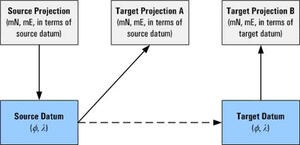A curved surface like the Earth cannot be laid flat without distorting it in some way. Projections are used to manage these distortions for representing a section of the Earth as a map, plan and on-screen visualisation.
Different projections work better in different situations, but this means that data from different geospatial datasets, such as coordinates, may not be compatible. Errors will occur if data isn’t in terms of the same projection.
Coordinate systems used in New Zealand
Our online coordinate converter gives examples of the expected input data based on options selected.

Projection conversions within the same datum
If the projection coordinates are in term of the same datum, for example converting from New Zealand Transverse Mercator 2000 (NZTM2000), to a NZGD2000 Meridional Circuit:
- Convert the coordinates to their geographic equivalent (latitude ϕ, longitude λ, and ellipsoidal height h).
- Reproject in terms of the target projection.
New Zealand Transverse Mercator 2000
Projection conversions between datums
If the current and target projection are in terms of a different datum, for example converting from New Zealand Map Grid to NZTM2000:
- Convert the coordinates to their geographic equivalent (latitude ϕ, longitude λ, and ellipsoidal height h).
- Transform the geographic coordinate to the new datum.
- Reproject in terms of the target projection.